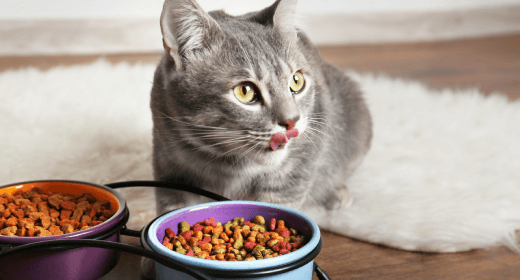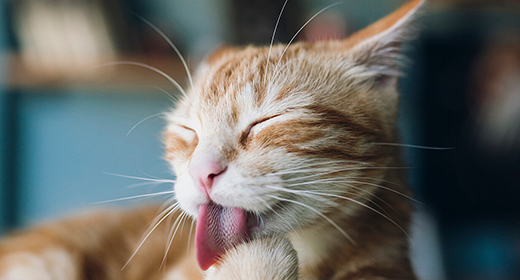

Good nutrition is as important to your cat as it is to you, but her nutritional needs are quite different! Unlike humans, a cat needs a high-fat diet with less fibre. Even if you prefer a vegetarian diet, you should understand that cats are carnivores. They need nutrients from animal protein and fat for optimal health, and they benefit from fibre for a healthy digestive tract and carbohydrates for energy.
With thousands of pet foods available, how do you pick the one that's right for your cat?
Start by identifying the cat's life stage and lifestyle. Kittens, nursing mothers, and mature/senior pets are examples of life stages, and each has different nutritional requirements. All cat foods should state which life stage they are recommended for.
Nutritional needs also vary depending on lifestyle. A cat whose primary activity is guarding the couch doesn't need as much energy as one who likes to spend time roaming outside.
Finally, it is important to take into account any special medical condition your cat may have, including food allergies that might require a special diet recommended by your veterinarian.
Once you've determined your cat's life stage and lifestyle needs, decide whether to feed dry or wet food. Most cats thrive on only dry food. This type of food promotes oral hygiene and health through abrasive action. Some cats, especially finicky eaters, enjoy the smooth and wet texture of canned or pouch foods.
Remember that, while dry food can be left in a bowl all day, wet food should be thrown away after 30 minutes if not eaten. Dry food is the best choice for busy people who are not normally home during the day.
Once you know your pet's nutritional needs and your pet's preference, you are ready to go shopping.
Because cats need the nutrients found in animal sources, it’s best to pick a food in which a primary ingredient (one of the first ones listed) is an animal-based protein source such as chicken, lamb, fish, egg, or one of their by-products. These ingredients contain all the essential amino acids, including taurine, which isn’t found in a vegetable-based protein source.
Using a combination of carbohydrates in a diet, such as corn meal or barley and grain sorghum, ensures efficient absorption and helps maintain energy levels. And beet pulp is an excellent fibre source that promotes a healthy digestive tract.
For a soft, thick coat and healthy skin, your pet needs fatty acids like those found in vitamin-rich fish oils and quality fat sources such as chicken.
Cat food labels provide limited information on the nutritional value of your pet's food because labeling regulations do not allow manufacturers to describe the quality of ingredients on the package. A reputable pet food manufacturer can explain to you how they evaluate and assure the quality of their products.
When choosing food, the price on the bag, while important, is usually not the best consideration. A low price may indicate cheap ingredients, or ingredients that change as manufacturer costs fluctuate.
In addition, many lower-priced products have higher daily portions to provide the same amount of nutrition found in a high-quality diet. To get a better idea of cost, it is the cost per feeding, not the total cost, that counts.
To figure cost per feeding, divide the total cost by the number of days the product lasts. For example, a 20-lb bag of food that costs $18.99 and lasts 30 days is $0.63 per day. A 20-lb bag that costs $15.99 and lasts 20 days costs $0.80 per day. When compared closely, high-quality pet foods are quite favourable to other brands.


Cats are known to be solitary creatures and enjoy spending time with themselves. However, as a pet parent, you must ensure that your cat remains healthy. It is advisable to keep an eye on your cat’s behavior to detect a sudden change, even what it eats, and in how much quantity. A regular health checkup is one of the most basic yet essential steps to a cat/kitty care guide. Taking care of cats is comparatively easier than taking care of kittens. A diligently followed routine for cat care can also be quite helpful.
Now that you have brought your cat home, the next step is to comfortably settle it in your house. Housetraining might sound like a tedious task but it isn’t. With a little practise and lots of patience, you can easily housetrain your cat. Some of the most basic things to keep in mind while housetraining your cat include providing a proper litter box, spaying your cat, toilet training and cat proofing the house. Given below are some tips that may help you easily housetrain your cat:
1) Place the cat’s litter box closer to the washroom.
2) Raise the height of the litter box a little every day.
3) Slowly, transition your cat to use the actual washroom every time it wants to go.
4) Give your cat a treat each time it uses the washroom. This will encourage good behavior.
Taking care of your cat’s health comes first in the cat/kitty care guide. Even though cats lick and self-groom themselves, they cannot get better on their own if they contract the following diseases:
If you notice unaccountable minor changes in your cat, then it is advisable to rush to the vet to rule out any of the above-mentioned diseases and seek proper treatment on time.
‘How to take care of a cat’ is a question asked by many first-time cat owners, as cats can be difficult to figure out. But with a few careful steps, you can easily take care of your cat. Here are some cat care tips for first-time cat owners: